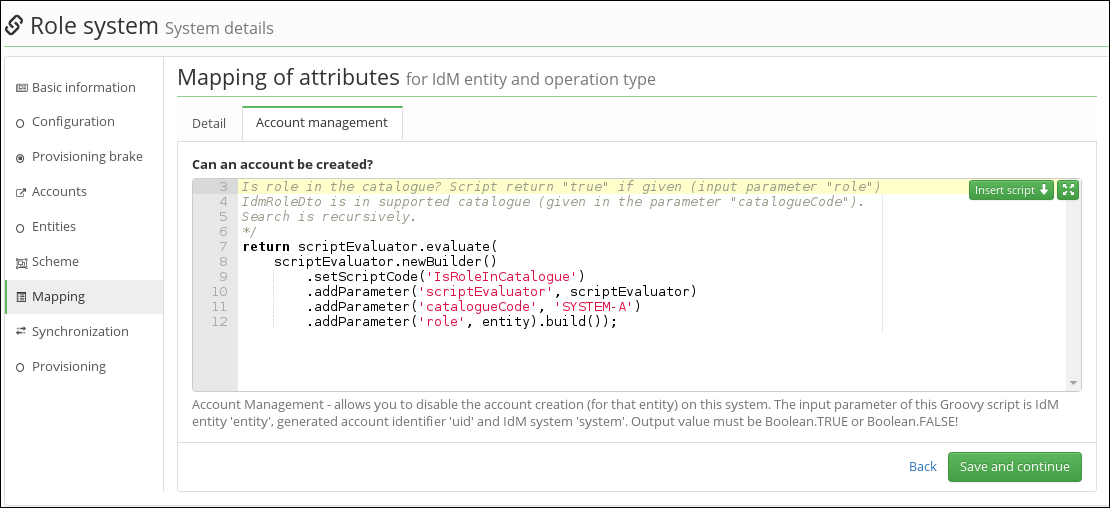Table of Contents
Account Management
The aim of the account management is to create accounts in the IdM internal warehouse (AccAccount entity) in such a form in which they should be created (according to the IdM settings) on end systems. The account management therefore does not do the provisioning itself but it is its indicator in most cases.
Basic account management
The basic account management is using for all entities supports the provisioning except the identity. Identity have more complex account management using the roles assignments.
If the entity supports basic account management, then is executed method ProvisioningService.accountManagement after it is created/updated.
Method ProvisioningService.accountManagement ensure:
- Finds all systems with the provisioning mapping for this entity type.
- Generats account identifier
uidfor this entity. - For all found systems check if account with same
uidalready exists. If yes, then this method ends. - For all found systems check if his mapping has the script 'Can be account created?'. If is script filled, then is executed. If script returns
Boolean.FALSE, then account on this system will be not created (this method ends). - Account on the system is created (AccAccount).
- Relation between created account and entity are created too.
Script - Can be account created?
- This script can be defined on the system provisioning mapping.
- Is executed before any IdM account (AccAccount) is created (for identity type are executed too).
- Ensure if will be some IdM account on the system created.
- This script returns
Boolean.TRUE(for create the account) orBoolean.FALSE(for not create the account).
Script example - role catalogue
We will now show how we can use the script. Situation:
- We have system configured for provisioning IdM role (IdmRole) to the target system.
- Now we want to allow create accounts only for role wich are in the specific role catalogue.
Solution:
- We need to know how check if is role in the specific catalogue. For this we can use script Is role in the catalogue? defines in the file CoreIsRoleInCatalogue.xml.
- Fill out the script in the system mapping. You can use insert script button. Result scirpt should looks something like this:
return scriptEvaluator.evaluate(
scriptEvaluator.newBuilder()
.setScriptCode('IsRoleInCatalogue')
.addParameter('scriptEvaluator', scriptEvaluator)
.addParameter('catalogueCode', 'SYSTEM-A')
.addParameter('role', entity).build());
Where:
- 'role' defines IdM role which we testing.
- 'catalogueCode' defines code of role catalogue for which we allow create the account.
Identity account management
The account management is run depending on the event that can have an impact on the change of the account on the end system:
- The event of the creation/modification/deletion of an identity.
- The event for creating/modifying/deleting the assigned role to a given identity.
- The event for creating/modifying the definition of mapping the attributes for a role.
The identity account management is ensured by the service AccAccountManagementService with the following methods:
- boolean resolveIdentityAccounts(IdmIdentityDto identity) - will evaluate the account for this identity depending on the roles that are currently assigned to it. Returns true if it is requested to do provisioning.
- deleteIdentityAccount(IdmIdentityRoleDto identityRole) - will delete the accounts created within the assignment of this role.
- String generateUID(AbstractDto dto, SysRoleSystem roleSystem) - will generate a UID for the identity and the system. If there are overloaded attributes for UID, they are used, if not, the default attribute for UID is used.
Example of account life cycle
We have a provisioning mapping system and a primary attribute (marks as Is identifier). In this attribute, we will have a transformation into the system, the output of which will be the username with the postfix @idm.eu.
- Assign a role to this system to, for example, user john-doe.
- An internal account (AccAccount) will be created in IDM, where the value of this account (UID) will be john-doe@idm.eu.
- After an internal account is created, provisioning will be made on the end system. This creates a new account john-doe@idm.eu on the end system.
- If there is a change in the way the IDM of the account ID is being created. For example, the script will change so that postfix will be new @czechidm.eu, then john-doe@czechidm.eu will be returned during the provisioning from the primary attribute. This new value will also be stored in your account ID (AccAccount.uid).
Name of account in IDM
Name of account is in IDM stored in the entity AccAccount (field UID). This name is an internal account name and is particularly important when account management is executed but provisioning has not yet. At this point, the account name is the only account identifier. After a end system is called (provisioning), SysSystemEntity is created (updating) and contains the account identifier returned by the system. This identifier may be different from the one stored in AccAccount.uid , and it always takes precedence over communication with the end system.
During synchronization from the end system to IDM, an internal IDM account (AccAccount) is also created. In this case, an attribute identified as an identifier is used to generate the account name. A transformation from the system is called for this.
